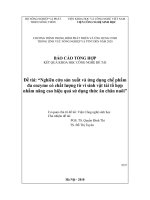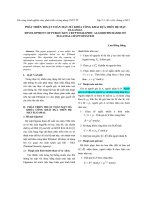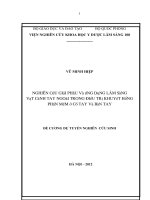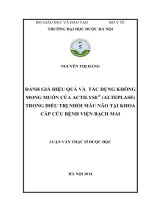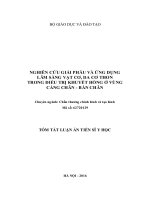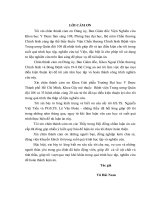Nghiên cứu giải phẫu và ứng dụng lâm sàng thần kinh cơ cắn trong điều trị liệt mặt giai đoạn bán cấp tt tiếng anhg
Bạn đang xem bản rút gọn của tài liệu. Xem và tải ngay bản đầy đủ của tài liệu tại đây (263.59 KB, 27 trang )
MINISTRY OF EDUCATION AND TRAINING
MINISTRY OF DEFENCE
108 INSTITUTE OF CLINICAL MEDICAL AND
PHARMACEUTICAL SCIENCES
--------------------------------------------------------
BUI MAI ANH
ANATOMICAL RESEARCH AND CLINICAL
APPLICATIONS OF MASSETER NERVE IN INTERMEDIATE
DURATION FACIAL PARALYSIS TREATMENT
Speciality: Odonto-Stomatology
Code: 62720601
ABSTRACT OF MEDICAL PHD THESIS
Hanoi – 2019
Thesis is completed at:
108 INSTITUTE OF CLINICAL MEDICAL AND
PHARMACEUTICAL SCIENCES
Supervisor:
1. Prof.PhD. Nguyen Tai Son
Reviewer:
1.
The thesis will be defended infront of the Institute-level Council of Thesis
Assessment met at:108 Institute of Clinical Medical and Pharmaceutical
Sciences at ...... h .......in
2019
The thesis can be found at:
1. National Library of Vietnam
2. Library of 108 Institute of Clinical Medical and Pharmaceutical Sciences
1
INTRODUCTION
The injury of the nerve VII due to various causes makes paralysis of
facial muscles. The functions of facial muscles play an important role in
communication. The injury of the nerve VII also causes some functional
effects such as eye protection function. There are many studies offering
different methods of surgey to reduce facial deformity, but each method of
surgery is effective only on each patient and donor nerve that was intervened
by surgery .
Facial nerve injury at an early stage of less than 2 years has the ability
to be restored by direct surgical intervention. However, the use of adjacent
nerves only resolves the problem of active facial vibrations and is not identical
to the healthy half-face.
Facial nerve graft has been studied by many authors for a long time.
However, this method is still limited. Masseteric nerve surgery is used to
replace the old method with positive results.
In Vietnam, surgery for facial paralysis treatment has been carried out for a
long time. However, there has not been any study on surgery and applications
of masseteric nerve in a systematic way, so we conduct research on the topic
”Anatomical research and clinical applications of masseter nerve in
intermediate duration facial paralysis treatment” for the following
purposes:
1. Course of masseteric nerve anatomy.
2. Evaluate results of the applications of masseteric nerve in surgical
treatment of intermediate durationfacial paralysis.
2
Chapter 1
OVERVIEW
1.1. Masseteric nerve
The nerve that regulates masseter musclemovement is called
masseteric nerve (MN), a branch from the anterior trunk of mandibular nerve.
- Branching: According to some studies, MN has branching in some
cases.
- Location: According to Kun Hwang, MN is located at 33 ± 5.6 mm
from the lower limit of masseter muscleon the longitudinal line 1/3 before the
masseter muscle and 47 ± 5.5 mm from the lower limit on the vertical line 1/3
after.
- Microscopic anatomy: Through microscopic anatomical results, it
can be seen that the number of MN axons is much larger than other nerves,
which is one of the good conditions for recovering nerve transmission when it
is used as a source.
1.2. Surgical methods to restore facial muscles by the time of paralysis
1.2.1. Acute facial paralysis (paralysis time <3 weeks)
- Purpose: release pressure for the nerve VII or nervous joint, transplantation
to restore function of facial muscles.
- Methods:
+ Direct neuronal joint: apply to all cases of the nerve broken for injury,
surgery with condition of 2 nerve endings after the excision with organization
defect under 1cm
+ One-sidedness facial nerve segmentation graft: apply when injured nerve
deficiency is 1cm or more.
3
1.2.2. Intermediate durationfacial paralysis (from 3 weeks to 2 years)
- Methods: Surgery for one-sidedness facial nerve graftor nervous graft
through the circuit.
- Facial nerve transition: The nerve often used is: nerve XII, masseteric nerve.
Transfer of nerves XII-VII: usually joined at the end - on the side and joined
to the main body of the nerve VII. Transfer of masseteric nerve – branch of
the nerve VII mouth on the side of the paralysis: usually linked to the end of
microsurgery of the MN branch and the nerve VII mouth branche.
1.2.3. Chronic facial paralysis(> 2 years)
- Methods:
+ Local muscle transfer surgery: the muscle often used is a temporal muscle
with the condition that the trigeminal nerve is not injured.
+ Micro-surgical transfer surgery: in cases where the transfer of local muscles
is difficult or has not the desired results, the free muscle transfer is a good
choice. Free muscles are commonly used: slim muscles, large back muscles,
small chest muscles, and muscles in form of big toe.
1.3. Situation of applications of masseteric nerve in facial paralysis
treatment
1.3.1. Masseteric nerve transfer in intermediate durationfacial paralysis
treatment (<2 years)
Intermediate durationfacial paralysishas the ability to restore the nerve
VII transmission to recover the movement of the muscles clinging to face skin,
it is very positive because at this time the muscles clinging to face skin is not
degenerated, not atrophied.
With studies using nervous sources to recover the nerve VII
transmission from MN, many reports show very positive results even up to 24
4
month paralysis.
The authors suppose that due to distance of MN to the nerve VII branches is
quite close and the number of axons of MN is two to three times higher than
the number of axons of the wire VII branches, so the ability to recover is
higher than other nerves.
The synergy issue is also mentioned by the authors, but the reports
show that this is not too big issue for patients nor affect surgical results.
1.3.2. Using MN source in chronicfacial paralysis (> 2 years)
Like the direct transfer of MN, the use of MN for muscle
transplantation has many advantages such as ease of surgery, short recovery
time, the used nerve does not affect the function.
However, the authors also said that the use has disadvantages such as
when lifting the edge, it is necessary to bite with the bitting and the time to
create a natural smile must be 2-4 years after surgery. To overcome this
problem, some authors have used dual nervous joint with two places: MN and
facial nerves with the movement nerves of the grafted muscle to create
spontaneous and natural laughs. In 2012, Biglioli reported a series of free
muscle grafts, with two nervous sources (MN, facial nerves) and very positive
results.
In the future, functional magnetic resonance imaging may be used to
study this process in facial paralysis and to explore the cortex areas that are
activated while smiling with the patients who use MN as source of free muscle
transplantation. To achieve in spontaneous way, symmetrical smiles, an
important part is due to post-operative recovery of smile function when
standing in front of the mirror with exercises and biofeedback.
1.3.3. In Viet Nam
5
In Vietnam, peripheral neuropathy joint techniques are also performed
by many surgeons in orthopedic, neurosurgical and jaw surgery. From the
1990s, N.B. Hung (1998), N.H.Phan (1999) used micro vascular-neuromicrosurgical techniques to more accurately suture and join, Dr. Son (2000)
reported on the technique of suturing and covering the bundle of fibers in the
nervous joint and transplant. The use of facial nerves in the nerve VII recovery
has also been reported by author N.T.Son since 2003, with positive results and
one of the options in the facial paralysis treatment. Studies on anatomy and
MN applications have also been reported, but there have been no further
studies on anatomy and application on Vietnamese people.
6
Chapter 2
RESEARCH SUBJECTS AND METHODS
2.1. Research subjects
- Research on fresh cadaver: 22 specimens /11 fresh cadaver (including 6 men
and 5 women) from 35-73 years old, 9 fresh cadaver were studied in Ho Chi
Minh City University of Medicine and Pharmacy, 02 fresh cadaver at Viet
Duc Hospital, unknown age (unidentified cadaver)
- Clinical research: Patients with facial paralysisdue to various causes
in the period from 3 weeks to 24 months had surgery to transfer one-sidedness
MN at the Department of Maxillofacial Surgery-Plastic Surgery-Aesthetics,
Viet Duc Hospital from 11 / 2009-12 / 2017.
2.1.1. Selection criteria and exclusion of patients
- Criteria for selection on cadaver: The specimens on the fresh cadaver
are intact in the face area, have not been surgically or previously injured.
Exclude specimens that are not properly preserved, face areas are injured.
- Criteria for patients selection: Patients with facial paralysisaccording
to FNGS 2.0 classification from grade 4 to grade 6 for not more than 24
months
paralysis;
The
patients
were
diagnosed
with
intermediate
durationfacial paralysis; For facial paralysis patients with unidentified
paralysis causes (Bell paralysis), the time for surgery indication is more than 6
months if there is no sign of clinical recovery; There are no systemic diseases
that endanger the surgery; had surgical treatment in plastic surgery and
maxillofacial surgery; Follow up patients after periodic treatment of 1 month,
3 months ... until the end of the studies.
2.2. RESEARCH METHODS
7
2.2.1. Research design:
- Research on fresh cadaver: Observation and description research
- Clinical research: Retrospective, prospective, clinical intervention, noncontrolled
2.2.2. Research facilities and equipment
- Research on fresh cadaver:
+ Use surgical instruments, measurer, loupe
+ Carry out the surgery on each side of fresh corpse, with supine position of
the head tilted to the opposite side.
+ Skin incision along Blair incision line from the temple through the tragus to
the jaw corner about 1/3 of the length of mandibularbone.
+ Operate of the facial muscle layer, operate to the front bank, the bank on the
salivary glands.
+ From the anterior border of the parotid glands, operate to find branches of
the nerve VII: the mouth branch, the cheek branch. Then retrograde surgery
into the parotid salivary glands.
+ Remove the shallow lobe of glands that preserve nerve VII branches.
+ Reveal the whole nerve VII.
+ Continue to remove the deep lobe to expose the entire masseter muscle
below.
+ Measure the index of masseter muscle as below.
+ Continue operating the layers of masseter muscle, peeling according to the
layers.
+ Find donor nerve and masseter muscle arteries in the deep layer of masseter
muscle.
+ Measure indicators.
8
- Clinical research:
+ Clinical examination of the patients: assessing injury status of the nerve VII
according to House and Brackmann score (FNGS 2.0); measure commissure
excursion amplitude; assessment of facial nerve injury; masseteric muscle
function; classify causes of injury; body situation.
+ Subclinical assessment: MRI, CT to search for causes of the nerve VII
injury; EMG to determine vulnerability; do tests to exclude other diseases.
+ Perform the surgery
2.2.3. Improved content in surgery to find MN
Through clinical and anatomical researches on the fresh cadaver, we map out
the "MN zone” as follows:
+ Upper limit: zygomatic branch.
+ Lower limit: buccal branch
+ Posterior limit: the parallel line and measure the distance from the tragus to
the branching position of MN.
+ Anterior limit: the line parallel to the posterior limit and about 1cm from the
posterior limit.
MN zone is limited when connected 04 lines above and in the deep layer of
masseter muscle.
2.2.4. Follow uppost operation
- The patient was monitored at the hospital during 5-07 days.
- Follow up immediately after surgery about hematoma, bleeding, infection.
- Periodic observation: 03 months, 06 months, 12 months to assess the time of
axon regeneration by manifesting the movement of facial muscles clinically.
- Evaluation of the time onset of vibration based on the patient perception
when biting, it will result in muscle vibrations of the mouth in paralysis side.
9
- Evaluate the time when the patients can laugh spontaneously without bitting.
- Evaluate postoperative masseter muscle function: measuring the maximum
distance of the mouth opening, the patient's ability to chew.
- Evaluate by observation, grading according to FNGS 2.0, measure
commissure excursion calculated from the middle of the upper lip. Compare
before and after surgery by taking pictures, filming, electromyography.
2.2.5. Rehabilitation post operation
- Immediately during the first week after surgery, the patient is instructed to
eat by chewing on the surgery side to increase neurotransmitter ability.
- The first month after surgery, the patient does not massage the surgical side.
Gentle massage will be performed after surgery from the second month.
- The patient will practice regular chewing on the surgical side until the first
signs of muscle self-perceived by the patient for 3-6 months.
- After the first signs of muscle vibration, the patient will have to practice in
front of the mirror: clenching the teeth with a smirk, and making symestry
smile at least 02-03 times / day. Every 15-20 minutes.
- Rehabilitation with the mirror will help patients to separate movements by
adjusting the bitting force. Therefore, it limits the synkinesis.
- Patients will always understand that biting will motivate and equilibrate
mouth corners, which will help create a pathway from the adaptor cortical and
patients can have a natural, spontaneous smile after the practice from 24-72
months.
10
2.3. Data processing
- Analysis on software STATA 12.0
- Research classification is as follows:
Type 1: Very good
- FNGS 2.0: Grade I, Grade II.
- Electromechanics: There are signs of the movement unit of the facial muscle
(optional conditions).
- Spontaneaous smile
- Difference in amplitude from the healthy side is <3 mm.
Type 2: Good
- FNGS 2.0: Grade I, Grade II.
- Electromechanics: There are signs of the movement unit of the facial
muscle(optional conditions).
- Movement needs bit with bitting
- Difference in amplitude from the healthy side is <5 mm.
Type 3: Fairly
- FNGS 2.0: Grade III
- Electromechanics: There are signs of the movement unit of the facial
muscle(optional conditions).
- Movement needs bit with bitting
- Difference in amplitude from the healthy side is ≥5 mm.
Type 4: Average
- FNGS 2.0: Grade IV
- Movement needs bit with bitting
- Difference in amplitude from the healthy side is >5 mm.
- Electromechanics: There are signs of the movement unit of the facial
11
muscle(optional conditions).
Type 5: Poor
- FNGS 2.0: Grade V, VI
- Movement needs bit with bitting
- Difference in amplitude of the mouth movement calculeted from the upper
lip middle is small or quite zero.
- Electromechanics: There is no electric potential difference when biting
2.4. Ethics in research
- Objectives and methods should be considered carefully so that the benefit of
patients is priority 1.
- Patients voluntarily participate in research
- Information security and use for research purposes.
12
Chapter 3
RESEARCH RESULTS
3.1. Research results of MN anatomy
Observe 22 cadaver specimens (12 men, 10 women), average age of
69.7; number of bite layers: 3; masseter muscle length: 64.4 ± 3.9; masseter
muscle width: 37.4 ± 3.6. The distance from the tragus to the branching point
under MN is 33.2 ± 2.6; The distance from the cheek bow to the branching
point under MN is 7.8 ± 0.8; The distance from the zygomatic arch to the
branching point under MN is 5.8 ± 0.8; The distance from the jaw corner to
MN is 54.2 ± 12.6; The distance from the mouth branch of the nerve VII to the
branching point under MN is 11.2 ± 3.0. There are no statistically significant
differences in men and women. There is difference, but not statistically
significant between the MN location on the corpse and on the surgery, the
distance from the tragus to MN on the corpse is larger than on the surgery but
not significant. MN was found in the deep layer of the masseter muscle and
between the cheekbone branch and the mouth branch of the nerve VII, before
the tragus 29.9 ± 2.5 mm.
3.2. Surgical results
3.2.1. Short term results
Complications after surgery: Infection, fluid accumulation, saliva
leakage are not seen in any case. The effect of the proximal results is
calculated on the time of time onset of vibrationand the commissure excursion
movement when biting after surgery.
Table 3.13.Onset-vibration muscle time with the bitting (n = 32)
13
Time of the first muscle vibration
(month)
Mean ± SD
Min
Max
Coaptation to the buccal branch (n=23)
3.5 ± 1.1
2–6
Coaptation to the buccal and zygoma
branch (n=4)
4.3 ± 1.5
3–6
Coaptation to the main trunk (n=5)
4.6 ± 0.5
4–5
– P
0.045
All the cases (n=32)
4.3 ± 3.7
2–6
Remark: After surgery, the time of the time onset of vibrationwith the
bitting is 3.5 ± 1, 07 months; of the group coapted 02 branches is 4.3 ± 1.5
months; with the main body joint group is 4.6 ± 0.5 months and the average is 4.3
± 3.7 months. This difference is statistically significant with p <0.05. The sign of
the time onset of vibrationwas felt by the patient itself, so only 32 patients
reported the time of the first muscle vibration when the jaw was closed.
Table 3.14 Onset motion time with the bittingand grading according to
FNGS 2.0
Mean ± SD
Min – Max
Mean ± SD
Min – Max
Mean ± SD
Min – Max
Mean ± SD
Min - Max
The first commissure excursion on Mean ± SD
the paralysis side with bitting Min – Max
(n=30)
Grade I
Grade II
Grade III
Coaptation to the buccal branch
(n=23)
Coaptation to the buccal and
zygoma branch (n=4)
Coaptation to the main trunk
(n=5)
All the cases (n=32)
5.6 ± 3.8
3 – 24
5.75 ± 0.5
5-6
5.4 ± 0.9
4–6
5.6 ± 3.4
3 – 24
5.4 ± 2.1
3–9
0
4
21
0
13.3
70,0
14
Grade IV
5
16.7
Grade V
0
0
Grade VI
0
0
Remark: The time averageof the first commissure excursion movement with
FNGS 2.0 (n=30)
the bittingin the group connecting the mouth branch is 5.6 ± 3.8 months; The 2
branch coapted group is the main body coapted group: 5.75 ± 0.5 months, the
main body group is 5.4 ± 2.1 months. The average initial amplitude of the first
commissure excursionmovement on the paralysis side is 5.4 ± 2.1 mm. The
majority of patients with FNGS 2.0 results reached the grade III (70.0%). In
this results table, there is 01 patient who had surgery at the age of 18 months,
so he does not cooperate to move the muscle when biting with the bitting, until
after 24 months he accepted to cooperate and had the oral movement. The
results from 3-6 months of 06/36 patients who only sent pictures after surgery
so it was only possible to identify patients who could clearly move their
mouths when biting with the bitting but it is not scored according to the FNGS
2.0 score and not measured oral movement amplitude calculated from the
middle of the upper lip.
3.2.2. Long term results
Table 3.20.Long term results according to the House-Brackmann 2.0 score
on each factor (n = 36)
Characteristics
Eyebrow (point)
Eye (point)
Nasolabial fold(point)
Mean ± SD
Min – Max
Mean ± SD
Min – Max
Mean ± SD
Min – Max
Frequency
(n)
5.1 ± 0.8
3–6
1.4 ± 0.6
1–3
1.2 ± 0.4
1–3
Proportion
(%)
15
Mean ± SD
1.3 ± 0.8
Mouth (point)
Min – Max
1–5
Mean ± SD
0.7 ± 0.5
Synkinesis
Min – Max
0–2
Mean ± SD
9.7 ± 2.0
Total points
Min – Max
7 – 15
Grade I
0
0
Grade II
24
66,7
Grade
III
9
25.0
Grading by point
FNGS 2.0
Grade IV
3
8.3
Grade V
0
0
Grade VI
0
0
Remark: After surgery 6-72 months, the majority of patients had the
surgery result of grade II (66.7%); then grade III (25.0%); only 8.3% of
patients had a result of grade IV.
Grade I: Very good
Grade II: Good
Grade III: Fairly
Figure 3.1. The long term result according to the classification of the studies
Remark: According to the grading standard of the studies, the patients with
grade I results were very good, accounting for 38.9% and good for 27.8%,
only 8.3% of the patients had the average grade IV results.
16
Grade I
Grade II
Grade III
Grade VI
Before surgery
Recent results
Long term results
Figure 3.2. Change of FNGS 2.0 before and after surgery
Remark:
Before surgery, patients with grade VI are accounted for 72.2%, grade V for
16.7% and grade IV for 11.1%.
3-6 months after surgery, patients with grade IV are accounted for 70.0%,
grade V l for 16.7% and grade III for 13.3%.
6-72 months after surgery, patients with grade II are accounted for 66.7%,
grade III for 25.0% and grade IV for 8.3%.
17
Chapter 4
DISCUSSION
4.1. Masseter muscle anatomy
Through our studies of over 22 fresh corpse specimens of Vietnamese
people, masseter muscle anatomy has a length of 64.4 mm, width of 37.4 mm,
masseter muscle divided into 03 classes. According to Hwang's studies with
96 specimens that had a masseter muscle length of 66 ± 5.6 mm. In the
studies, we did not measure the length of MN but only measured the distance
from the Sigma hollow of 5.8 ± 0.8 mm to the point of branding under MN,
because this is the point that we choose and cut MN inferior branch to joint
microsurgery. We also measured the distance from the jaw corner to the
subdivision point under MN of 48.7 ± 16.9 mm (Table 3.4), compared with
Hwang's result from the jaw corner to the lower branch of 3.2 ± 4.1 mm.
Brenner and Schoeller studied on more than 36 cadaver specimens
and summarized that when MN entered the muscle, divided into 2 branches, is
seen in 47% of the specimens, only 1 branch is seen in 5% of the specimen, 3
branches seen in 25%, 2, 8% is divided into 4 branches. Cotrufo et al only saw
02 anatomical changes: only 1 branch in 14/17 specimens, 2 branches found in
3/17 specimens. In addition, more than 96 corpse specimens of Kun Hwang
and colleagues are divided into 03 anatomical changes: 1 branch, 2 branches
and 3 branches. According to our analysis results: 20/22 specimens had 2
branches, 02/22 had a branch. Thus, most of the results according to reports
are mainly MN divided into two upper branch and lower branch. This
anatomical feature is quite important because based on this result, we often
choose the nerve lower branch, used to joint microsurgery to the oral branch to
18
recover MN because this branch usually has large size and length. .
According to our analysis on 22 MN specimens located at the depth
layer of the masseter muscle, this is different from the author Hwang when he
found MN in the middle layer and the deep layer of the masseter muscle. This
difference may be due to the muscle layers division of the two different
studies.
The distance from the tragus to the position where the branch under MN
was found according to our researches does not have a difference in the two
sexes: the average in women is 33.3 mm, in men is 33.16 mm. The study of
Cotrufo et al was: 26, 5 mm in men and 20.2 mm in women. This is a quite
important point to relatively determine the good position of the MN inferior
branch. We also obtained the same results when operatingthe patients in fact.
Therefore, when clinically apply we also marked this position and draw line
parallel to the tragus and about 33 mm from here on the patient to locate MN.
Through the surgery on 22 specimens, we found that the zygoma and
the buccalbranches on the nerve VII, created the upper limit and lower limit,
which is very important for determining the MN inferior branch. In
Bermudez's studies, the author identifiedMN by looking for zygomabranch
and operating the masseter muscle under this branch to find the nerve. The
author Cotrufo determined by square drawn on the skin with the points
includingZygoma arch,tragus,buccal branch. However, we find that this
determination is still quite difficult because when operating the patients, we
are forced to peel off the skin layer so thesepoints on the skin will be very
difficult to compare. We found that during surgery for coapted the nerve VII,
surgeons often have to find the oral branch of the nerve VII, the more accurate
identification of thisdonor nerve can be usednervous stimulation pen.
19
Therefore, we consider this as the lower limit, while the zygomaticbranchis
the upper limit, with the line parallel to the tragus and about 33.2 mm from the
tragus. Through this diagram, we found MN in the deep layer of masseter
muscle on 22 specimens. The determination of this diagram is also studied
when we operate on patients (please refer to the surgical section).
The diameter we measured on the corpse specimens between the two
ends of the nerve, the oral branch and MN,is relatively similar: 1.1 mm and
1.2 mm. In previous studies by foreign authors, we do not see the presentation
of MN headdiameter, although this is also an important factor in
nervouscoapted technique. However, in clinical practice we found that the MN
inferior branch is always very small and there is only one nervousfiber bundle
so we try to joint all nervous fiber bundles of the nerve VII branches or the
suralnerve with the fiber bundle of MN inferior branch.
4.2. Surgical results
4.2.1. Short-term results
Our assessment of recent postoperative results is based on the time of
the time onset of vibrationafter surgery, the time of the first commissure
excursion movement at paralysis side after surgery with the bitting, the
amplitude of the first movement at paralysis side, compared with the healthy
side and FNGS 2.0 score. According to Murphey, in 10 articles, the time of
the time onset of vibrationin themain body coaptedgroup were 5.76 months on
average, while in the branchcoapted group it was 3.76 months. Therefore, we
choose the time to evaluate the recent results for 3-6 months after surgery. In
our studies, the time of the time onset of vibrationof the buccal branchcoapted
patient was 3.5 months, of the two branchcoapted was 4.3 months, of the main
body was 4.6 months.Compared with some other authors, we have the average
20
time of the time onset of vibrationsimilar to results of other authors. The
authors Biglio and Bianchi do not join the branch VII directly to the MN
branch but join nerve roots through a compound. According to the author
Bianchi, this is why the time for neurotransmitter recovery is longer (8
months). In our patients group, there were 05 patients who were joined to the
original of the nerve VII with the average initial muscle vibration time of 4.6
months in accordance with the author Biglio. This shows that the axons
regeneration ability of MN wire is very high. In another studies, the
comparison of the neurotransmitter group XII and MN for the nerve VII of the
author Hontanilla showed that the transmission recovery time of MN averaged
62 days, while that of the nerve XII was 136 days.
The early recovery time of the nerve VII after MN transfer helps to
reduce facial area muscle degeneration, to increase the results of movement
recovery. As the medical literature has shown, before being used as a major
nerve for transmission recoveryof the nerve VII, MN has been used as a
support nerve (babysitter) while waiting for facial nerves that continued to
transmit.
The average time of the first commissure excursion movement in our
studies in coaptedbuccal branch group is 5.6 months, 5.75 months for the two
branch coapted group and 5.4 months for the main bodycoapted group.
According to Wang's report, this time is 6 months, Klebuc is 5.6 months. We
found that from the time we saw the time onset of vibrationuntil the patient
clearly and well movecommissure excursion with the bitting, it is quite fast
with 1 month on the average. This suggests that if there is a neurotransmitter,
the nervous movement recoveryappears and the movements will be
performed.
21
The paralysis grading according to the FNGS 2.0 score of the recent
results in our patients group who reached grade III for 70%; grade II for
13.3%; grade IV for 16. 7%. The average amplitude of commissure
excursionvibration at 3-6 months after surgery in our studies was 5.6 mm.
According to Hontanilla's studies, it was 7.8 mm. Many authors do not
measure the oral movement amplitude calculated from the upper lip middle at
the beginning but usually after 6-12 months of surgery when the muscles are
strong and clear.
According to the score, we found that the mouth branch was restored
to its earliest transmission, followed by the zygoma and eyehole branches. The
patient will have the first commissure excursionmovement and then close his
eyes. Many authors share the same comments with us,Biglio found that the
first visible nervous movement recovery is from large zygoma muscle. The
reason for this result has not yet been shown by any author, but in our opinion,
the mouth branch and the zygomaand eyehole branches are usually large and
are connected in the branches VII and dominate many facial muscles so when
recovering the nerve is usually faster than other branches.
4.2.2. Long-term results
Our follow-up period from a distance after surgery is from 12 to 96
months, Author Wang: 6-12 months; Klebuc: 7-84 months; Faria: 6-18 months
and Bianchi: 12-72 months. For nervous transmission reconstruction surgery
we find that the longer the follow-up time, the more likely the recovery will be
completely evaluated as well as the possible sequeleas of the nerve are the
source. Therefore, we will see advantages and disadvantages of the nerves.
According to the research results in our patient group, 100% of patients
hadmovement re-transmission and reached the research score: Very good is
22
38.9%, Good is 27.8%, Fairly is 25%.
In 36 patients with a follow-up period of 12 months or more, 91.7%
had a quite stable balance compared to the time before surgery, this rate was
16.7%. The rate reduced and the end of dryness, corneal redness, or
lacrimation with 100% compared to 55.56% before surgery. This shows that
the assessment results of the eyelid muscles recovery, whenthe eyelid muscles
are active, the patient can close the eyes. Closing the eyes will help prevent
dirt, dry eyes, red eyes or corneal ulcers.
Patients are clinically effective at scoring according to FNGS 2.0.
According to Table 3.29, the change of the FNGS 2.0 points total and the long
term results after surgery according to the average value varied from 22.9 to
9.7 with p <0.001 with statistical significance. Using the grading facial
paralysisof FNGS 2.0 as us, Biglio (2016) studied on 34 patients with followup time up to 3 years after surgery and Bianchi (2017) studied on 6 patients
with the time up to 06 years.
23
CONCLUSION
1. About MN anatomy
- Location: located in the deep layer (3rd layer) of the masseter
muscle, the average length is 64.4 mm, the average width is 37.4 mm. MN
comes along and in front of the masseter muscle artery. MN went through the
Sigma hollow, mandibularthen branched. MN divided into 2 branches
appearedin 20/22 specimens, into 3 branches in 2/22 specimens. The location
where we found MNin the middle of the upper buccal branch and the
zygomaticbranchnext to the bow is 100% specimens.
- Anatomical landmarks: The average distance from the tragus to MN
is 33.16 mm for men and 33.3 mm for women, and this distance is clinically
measured on 38 patients, 29.9 mm. The average distance from the zygoma to
the MN is 7.8 mm, from the Sigma hollow is 5.8 mm, from the jaw corneris
54, 2 mm, from the mouth branch of the nerve VII is 11.2 mm. The average
MN diameter is 1.1 mm, the diameter of the mouth branch of the nerve VII is
1 mm.
+ Upper limit: lower cheekbone branch.
+ Lower limit: upper mouth branch
+ Posterior limit: the parallel line and the distance from the tragus to
the MN branching position, taken according to the smallest value of the two
researchlots (on fresh cadaverand clinical bodies) is 28mm.
+ Anterior limit: The line parallel to the anterior limit and from the
tragus according to the maximum value of the two research lots (on fresh
cadaver and clinical bodies) is 40 mm.
2. Surgical results
The patient had the average time of the time onset of vibrationwith his

